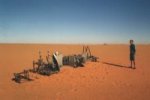


SAAF Blenheim Z.7513
Wreck now positively identified
The aircraft remains (and a moslim style grave nearby) were found approximately 6-8 kilometres from
the spot plotted based on the Court of Inquiry documents, on the only area in the vicinity that would readily
suggest itself as a landing area. (We have searched in the plotted area as well, with negative results.) As similar errors
were encountered at the initial force landing site, the location can be accepted to match the original description.
The following information was received from John Smith, engineer at the Conservation Department, IWM Aviation Museum, Duxford.
Sent: Sunday, December 16, 2001 12:39 PM
With a bit of luck I managed to find a copy of the Profile 218 Blenheim IV booklet on bookfinder.com (it came all the way from Australia).
Aside the photos in John's email, it contains a photo of a Blenheim in a steep bank, clearly showing it's underside. The crescent like panel
just below the jacking point inscription is clearly visible between the fuselage and the starbord engine, further confirming the wreck's identity.
Subject: Saaf Blenheim
Have looked at your website and the aircraft is definitely a Blenheim-
Photo 3 - Underside of centre section shows fuel lines as per Blenheim and also the bomb bay support structure for the bomb racks - the spar construction is individual to the Blenheim.
Photo 5 - The armour plate shows manufacturers initials WD&Co and the round stamp is the inspectors stamp.
Photo 6 - Standard Blenheim undercarriage and engine bearer construction showing the ferruled sleeves and peined down ends to the bolts. Numbers are component part numbers.
Photo 12/13 - If the fitting has a bulb holder in the end it is a standard light fitting which was mounted on a gimballed mount which would have been mounted over the observors table also above the windscreen for the pilots instrument panel and in the rear for use of the WOP/AG.
Sent: Thursday, December 20, 2001 11:55 PM
Subject: SAAF Blenheim
Attached is three views of Blenheim Z7513 taken in 1959 and was then obviously complete apart for some strange reason the removal of the rudder. I have taken the photos from a booklet called PROFILE 218 Bristol Blenheim MKIV but is quite an old publication and is not available now.
You mention that you found globules of molten aluminium, is it possible that the aircraft was cut up using oxy/acetylene cutting equipment.
Based on the above information there is now little doubt that the wreck is indeed Z.7513